See also
| This disambiguation page lists articles associated with the title Caracara. If an internal link led you here, you may wish to change the link to point directly to the intended article. |
Caracara or Carcara may refer to:
| This disambiguation page lists articles associated with the title Caracara. If an internal link led you here, you may wish to change the link to point directly to the intended article. |

Birds of prey or raptors include species of bird that primarily hunt and feed on vertebrates that are large relative to the hunter. Additionally, they have keen eyesight for detecting food at a distance or during flight, strong feet equipped with talons for grasping or killing prey, and powerful, curved beaks for tearing flesh. The term raptor is derived from the Latin word rapio, meaning to seize or take by force. In addition to hunting live prey, most also eat carrion, at least occasionally, and vultures and condors eat carrion as their main food source.
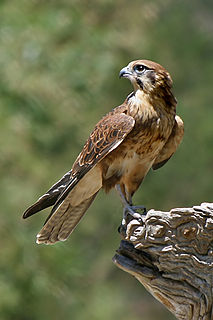
The falcons and caracaras are around 60 species of diurnal birds of prey that make up the order Falconiformes. The family is divided into two subfamilies, Polyborinae, which includes the caracaras and forest falcons, and Falconinae, the falcons, kestrels and falconets.

Macaws are long-tailed, often colorful, New World parrots. They are popular in aviculture or as companion parrots, although there are conservation concerns about several species in the wild.
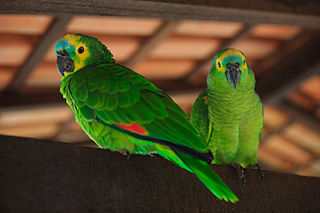
The family Psittacidae is one of three families of true parrots. It comprises the roughly 10 species of subfamily Psittacinae and 157 of subfamily Arinae, as well as several species that have gone extinct in recent centuries. Some of the most iconic birds in the world are represented here, such as the blue-and-gold macaw among the New World parrots and the grey parrot among the Old World parrots.

The Anserinae are a subfamily in the waterfowl family Anatidae. It includes the swans and true geese. Under alternative systematical concepts, it is split into two subfamilies, the Anserinae contain the geese and the ducks, while the Cygninae contain the swans.
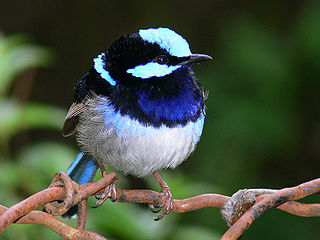
The Australasian wrens are a family, Maluridae, of small, insectivorous passerine birds endemic to Australia and New Guinea. While commonly known as wrens, they are unrelated to the true wrens. The family comprises 29 species in six genera.

Caracaras are birds of prey in the family Falconidae. They are traditionally placed in subfamily Polyborinae with the forest falcons, but are sometimes considered to constitute their own subfamily, Caracarinae, or classified as members of the true falcon subfamily, Falconinae. Caracaras are principally birds of South and Central America, just reaching the southern United States.

The northern crested caracara, also called the northern caracara and crested caracara, is a bird of prey in the family Falconidae. It was formerly considered conspecific with the southern caracara and the extinct Guadalupe caracara as the "crested caracara". It has also been known as Audubon's caracara. As with its relatives, the northern caracara was formerly placed in the genus Polyborus. Unlike the Falco falcons in the same family, the caracaras are not fast-flying aerial hunters, but are rather sluggish and often scavengers.

The Guadalupe caracara or mourning caracara is an extinct bird of prey belonging to the falcon family (Falconidae). It was, together with the closely related crested and southern caracara, formerly placed in the genus Polyborus. It was also known as the quelili or the calalie.
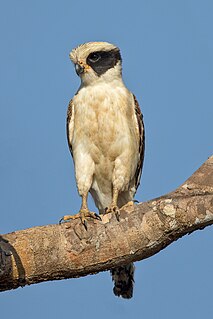
The laughing falcon, also called the snake hawk, is a medium-sized bird of prey in the falcon family (Falconidae), the only member of the genus Herpetotheres. This Neotropical species is a specialist snake-eater. Its common and scientific names both refer to its distinctive voice.

The yellow-headed caracara is a bird of prey in the family Falconidae. It is found in tropical and subtropical South America and the southern portion of Central America. Unlike the falcons in the same family, the caracara is not a fast-flying aerial hunter, but is rather sluggish and often obtains food by scavenging.

The southern crested caracara, also known as the southern caracara, carancho or carcará, is a bird of prey in the family Falconidae. As presently defined, the southern crested caracara is restricted to central and southern South America. It formerly included the northern crested caracara of the southern United States, Mexico, Central America and northern South America, and the extinct Guadalupe caracara as subspecies. As its relatives, it was formerly placed in the genus Polyborus.

Avulavirinae is a subfamily of viruses in the family Paramyxoviridae. Members of the subfamily are collectively known as avulaviruses. All members of the subfamily primarily infect birds. Avulavirinae was previously recognized as the genus Avulavirus before being elevated to a subfamily. The term avula comes from "avian rubula", distinguishing it from rubulaviruses of the subfamily Rubulavirinae due to avulaviruses only infecting birds and translating protein V from an edited RNA transcript. The most notable avulavirus is the Newcastle disease virus, a strain of Avian orthoavulavirus 1.

The black caracara is a species of bird of prey in the Falconidae family found in Amazonian and French Guiana lowlands, commonly along rivers. They are locally referred to as Ger' futu busikaka in the Republic of Suriname or juápipi {nẽjõmbʌ} by the Emberá of Panama and Colombia. Both these names refer to multiple bird species within Falconidae. German-Brazilian ornithologist Helmut Sick also referred to this species as Gaviao-deAnta, literally translating to "tapir-hawk".
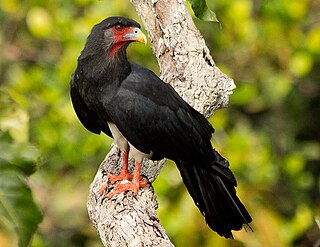
The red-throated caracara is a social species of bird of prey in the family Falconidae. It is placed in the monotypic genus Ibycter, or sometimes united in Daptrius with the black caracara. Unique among caracaras, it mainly feeds on the larvae of bees and wasps, but also takes the adult insects and fruits and berries.

Milvago is a genus of bird of prey in the Falconidae family.

The mountain caracara is a species of bird of prey in the family Falconidae. It is found in puna and páramo in the Andes, ranging from southern Ecuador, through Peru and Bolivia, to northern Argentina and Chile. It is generally uncommon to fairly common. It resembles the closely related Carunculated Caracara and White-throated Caracara, but unlike those species, its chest is uniform black. Juveniles are far less distinctive than the red-faced pied adults, being overall brown with dull pinkish-grey facial skin.

Caracara is a genus in the family Falconidae and the subfamily Polyborinae. It contains two extant species, the northern and southern crested caracara, and one extinct species, the Guadalupe caracara. The only visible difference between the two living species is that the southern species possesses more barred plumage than the northern species. The minor physical differences between these species resulted in their originally being treated as conspecific.

"Caracara" is the second solo single by South African recording artist K.O, featuring Kid X, released by Cashtime Life on 3 March 2014. It was released on various digital platforms. A major crossover hit, "Caracara" peaked at number 6 on South Africa's official music chart. It was the first South African music video to surpass 1 million views on YouTube.